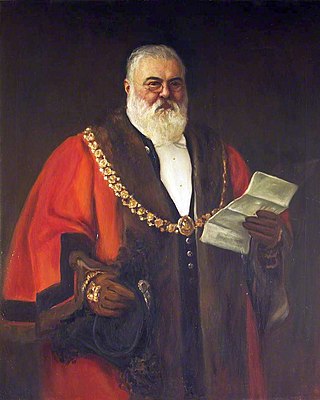Related Research Articles

Sir George Gilbert Scott, largely known as Sir Gilbert Scott, was a prolific English Gothic Revival architect, chiefly associated with the design, building and renovation of churches and cathedrals, although he started his career as a leading designer of workhouses. Over 800 buildings were designed or altered by him.

Mill Hill School is a 13–18 co-educational independent, day and boarding school in Mill Hill, London, England that was established in 1807. It is a member of the Headmasters' and Headmistresses' Conference.

Edward Burtenshaw Sugden, 1st Baron Saint Leonards, was a British lawyer, judge and Conservative politician.

Sir Horace Jones was an English architect particularly noted for his work as architect and surveyor to the City of London from 1864 until his death. He served as president of the Royal Institute of British Architects from 1882 until 1884, and was knighted in 1886. His most recognised work, Tower Bridge, was completed posthumously.
Francis Thomas de Grey Cowper, 7th Earl Cowper, known as Viscount Fordwich from 1837 to 1856, was a British Liberal politician. He was Lord Lieutenant of Ireland from 1880 to 1882.

Hugh Fortescue, 2nd Earl Fortescue KG, PC, styled Viscount Ebrington from 1789 to 1841, was a British Whig politician. He served as Lord Lieutenant of Ireland from 1839 to 1841.

William Henry Wills, 1st Baron Winterstoke, known as Sir William Wills, Bt., between 1893 and 1906, was a British businessman, philanthropist and Liberal politician.

University College, Bristol was an educational institution which existed from 1876 to 1909. It was the predecessor institution to the University of Bristol, which gained a royal charter in 1909. During its time the college mainly served the middle classes of Bristol, and catered for young men who had entered a family business and needed a greater understanding of scientific topics.

The Wills Memorial Building is a neo-Gothic building in Bristol, England, designed by Sir George Oatley and built as a memorial to Henry Overton Wills III by his sons George and Henry Wills. Begun in 1915 and not opened until 1925, it is considered one of the last great Gothic buildings to be built in England.

William John Wills was a British surveyor who also trained as a surgeon. Wills achieved fame as the second-in-command of the ill-fated Burke and Wills expedition, which was the first expedition to cross Australia from south to north, finding a route across the continent from the settled areas of Victoria to the Gulf of Carpentaria.
Philip Charles Hardwick was an English architect.

Caversham Park is a Victorian-era stately home with parkland in the suburb of Caversham on the outskirts of Reading, England. Historically located in Oxfordshire, it became part of Berkshire with boundary changes in 1911. Caversham Park was home to BBC Monitoring and BBC Radio Berkshire. The park is listed as Grade II in the English Heritage Register of Historic Parks and Gardens.

Henry Overton Wills III of Kelston Knoll, near Bath in Somerset, was a prominent and wealthy member of the Bristol tobacco manufacturing family of Wills which founded the firm of W. D. & H. O. Wills. As a philanthropist his best-known act was the funding of the University of Bristol, founded in 1909, of which he became the first Chancellor.
Sir Frederick Wills, 1st Baronet was a businessman, philanthropist and politician in the United Kingdom. He was a director of W. D. & H. O. Wills, a famous tobacco company headquartered in Bristol which later merged into the Imperial Tobacco Company.
Sir George Alfred Wills, 1st Baronet of Blagdon was a President of Imperial Tobacco and the head of an eminent Bristol family.
Queen Anne's School is an independent boarding and day school for girls aged 11 to 18, situated in the suburb of Caversham just north of the River Thames and Reading town centre and occupying a 35-acre (14 ha) campus. There are around 450 pupils. Nearly half are boarders. Some stay seven nights a week; others stay during the working week or two, three or four nights a week. Saturday morning lessons were replaced in 2009 by a programme of optional sport, hobbies and extended learning activities, including rowing, horse riding, textiles and first aid. The school awards scholarships in academic subjects, sport, music, art and drama at ages 11 and 13 and at sixth form entry.

The West Memorial Hall, or West Memorial Institute, is a Victorian Grade II listed building at 7-9 Gosbrook Road, Caversham, Berkshire, designed by Alfred Waterhouse. The Hall is a former Baptist Free Church that has now been converted to apartments.

Captain Thomas Drake Tyrwhitt-Drake born Thomas Drake, later Thomas Drake Tyrwhitt, was a British Member of Parliament (MP) for Amersham from 1795 to 1810.

Sir Frank William Wills of Berkeley Square, Bristol, England, was a member of the Wills tobacco family, who became a noted British architect and went on to serve as Lord Mayor of Bristol.
Robert Maynard Leonard, sometimes credited as R. Maynard Leonard, was an English journalist, editor, and light poet, the editor of many anthologies of English verse.
References
- ↑ Malpas, John. Caversham Names. Reading: John Malpas, 1995, pp.33–34.
- ↑ The Academy to Educate the Sons of Liberal Gentlemen
- ↑ “LEONARD, Robert Maynard” in The Institution of Mechanical Engineers: Proposals for Membership (1900), p. 7